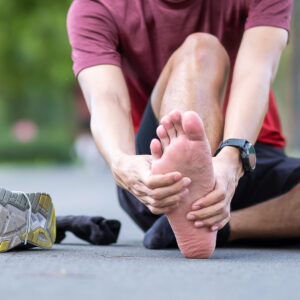How to Treat Plantar Fasciitis

Dealing with persistent heel pain? You’re not alone. Plantar fasciitis affects approximately two million people in the US and is a leading cause of discomfort in the heel and foot. To help, Stephanie Edwards, DPT, CSCS, a licensed physical therapist at Orlin & Cohen, explains common symptoms of plantar fasciitis, what causes it, and how to treat it.
Symptoms of Plantar Fasciitis
Plantar fasciitis causes pain and discomfort on the underside of your foot, particularly near the heel. It can make everyday tasks like standing or walking uncomfortable. Pain tends to be most intense when getting out of bed in the morning or after sitting for extended amounts of time.
While it may lessen as the day progresses, extended periods of activity can exacerbate it. Symptoms range from a persistent, dull ache to a sharp, stabbing pain when you apply weight to your affected foot or heel.
What Causes Plantar Fasciitis
As the name implies, plantar fasciitis results from inflammation of the plantar fascia, a thick band of tissue that starts at your heel, runs along the bottom of your foot, and attaches to your toes. The exact cause varies from person to person, but weight-bearing activities like excessive standing and walking can strain this tissue and contribute to the condition.
Other common causes of plantar fasciitis include:
Improper Movement
Overpronation is an exaggerated inward rolling motion of the foot during movements like walking and running, and can significantly strain the plantar fascia and surrounding tissues.
Maintaining proper foot mechanics, wearing suitable footwear, and practicing correct form during activities are crucial steps in preventing or alleviating this painful condition.
Sudden Increases in Physical Activity
Physical activity naturally places increased pressure on your plantar fascia. However, sudden increases in physical activity or excessive exercise can lead to stretching or small tears in the ligament, resulting in swelling and discomfort.
Activities like dancing, walking long distances, or rapidly incorporating hills into your running routine put repetitive strain on the feet. If not gradually introduced over time, they can contribute to plantar fasciitis. It’s best to ease into exercise and increase intensity over time.
Poorly Fitting Footwear
Wearing footwear without proper arch support is a common cause of plantar fasciitis, potentially leading to arch strain, micro-tears, and inflammation.
To alleviate discomfort and prevent worsening pain, choose shoes with adequate arch support and avoid tight or high-heeled footwear. Orthopedic shoes or orthotic insoles can offer additional cushioning and support proper foot positioning to help relieve pain.
How to Treat Plantar Fasciitis
In most cases, plantar fasciitis does not require surgery and conservative treatments, like the ones below, are effective.
RICE Method
The RICE method – rest, ice, compression, elevation – is one way to treat discomfort associated with plantar fasciitis treatment. Here’s how this four-step method works.
1. Rest
Rest is crucial for reducing strain on inflamed tissue and promoting healing. Taking breaks from weight-bearing activities can relieve pressure on your feet, reduce swelling and alleviate pain.
2. Ice
Cold therapy, like ice, constricts blood vessels, helping to reduce inflammation and pain. Apply ice for 15-20 minutes throughout the day to the bottom of your arch and heel to help alleviate discomfort from plantar fasciitis.
3. Compression
Compression is a valuable part of plantar fasciitis treatment, as it reduces swelling and supports the affected area.
You can wear compression socks during the day to manage swelling and support your foot. When going to sleep, night splints with compression can help maintain a foot position that relieves tension and tightness in the tissue.
4. Elevation
Finally, elevating your foot can help reduce swelling and alleviate some pain. When laying or sitting down, prop up your affected foot on pillows. Keep in mind elevation is most effective when the injured area is raised above the heart, so elevation will likely be most effective in a laying position.
Physical Therapy
Research shows that plantar fasciitis is a condition that responds well to physical therapy. This treatment can strengthen ligaments in the foot, increase strength and mobility, and ease pain.
At Orlin & Cohen, a certified physical therapist can evaluate your movements, create a tailored rehabilitation plan, and recommend at-home exercises to support your foot’s arch.
Every step shouldn’t be a painful journey. If you are dealing with pain from plantar fasciitis, we’ve got specialists for that. Orlin and Cohen’s team features some of the nation’s best orthopedists, including fellowship-trained foot & ankle specialists, who can help you feel better, faster. Request a same-day appointment.



